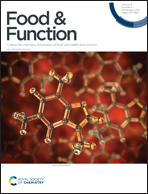The effects of different extraction methods on the aroma fingerprint, recombination and visualization of clam soup†
Abstract
Clam is a kind of nutritious, delicious and economical aquatic food around the world and is famous for its unique aroma. Instrumental analysis, sensory analysis, and comprehensive statistical analysis were performed to explain the relationship between aroma and odorants in clam soup. Six extraction methods combined with GC-MS and sniffing were utilized to obtain the aroma fingerprints of clam soup and to analyze the correlation with aroma perception. Solvent extraction methods were more effective than headspace extraction methods for the volatiles of clam soup. SAFE was the best method to obtain the most comprehensive information of volatiles of clam soup. The sequence of a combination of different extraction methods and SAFE would also affect the results of volatiles extracted from clam soup. Volatiles extracted via SDE, P&T, and SPME would add further information to the result of SAFE. A total of 119 volatile compounds were identified from clam soup by summarising the results of different extraction methods. The significant effect of 14 key odorants in clam soup on aroma perception was verified by aroma recombination and odorant omission tests. A neural network diagram of the aroma profile was designed to visualize the information of odor perception. Furthermore, the results would be beneficial for aroma research studies of aquatic food and the processing of clam products.



 Please wait while we load your content...
Please wait while we load your content...